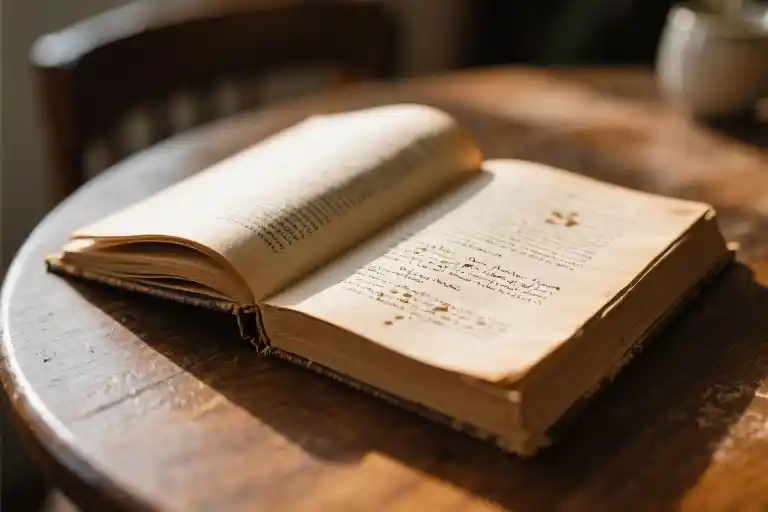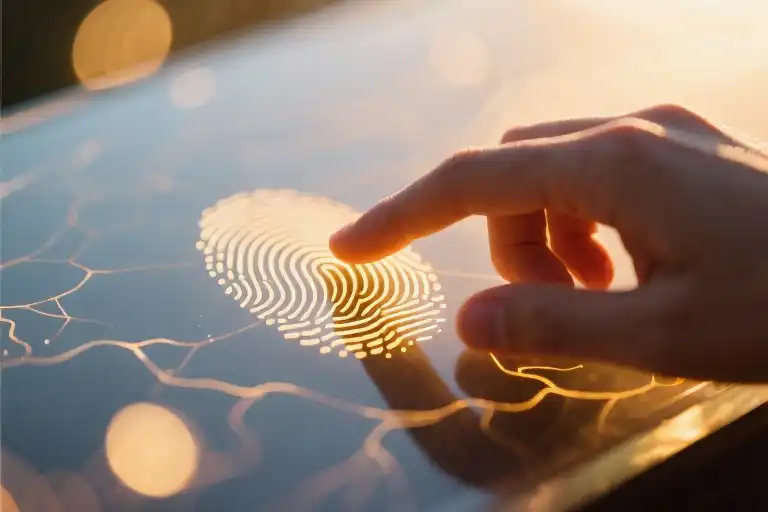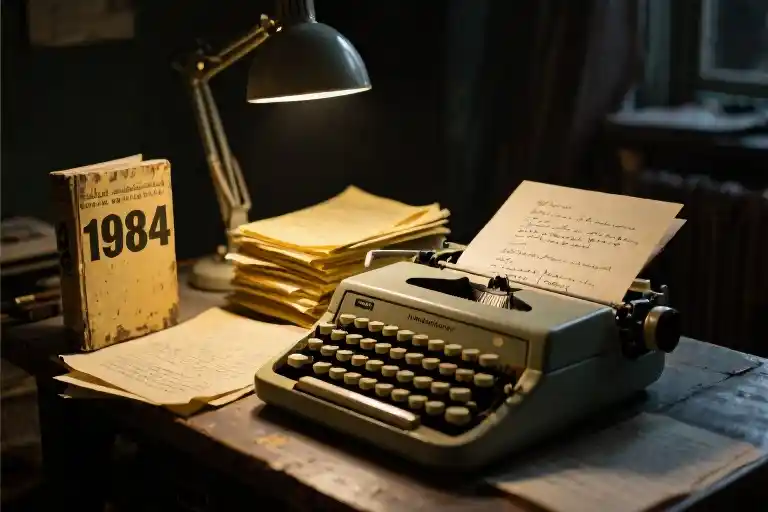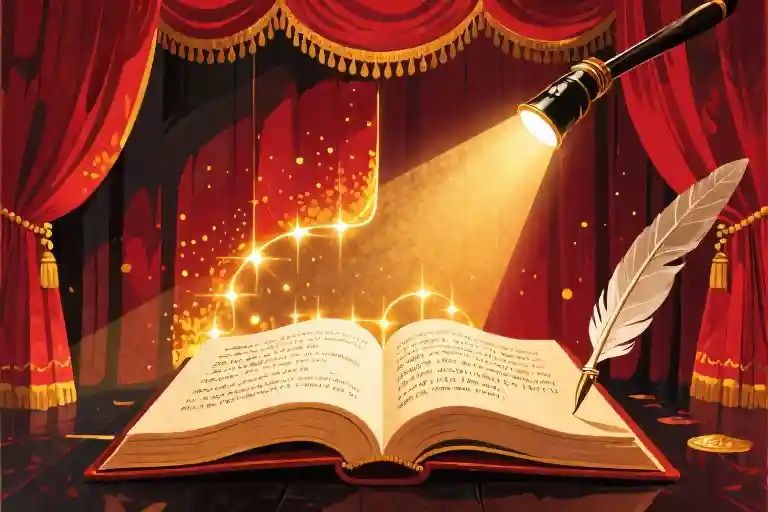The rain taps a hesitant rhythm against the windowpane as I pull the familiar weight of One Hundred Years of Solitude from the shelf. The jacket sleeve whispers against my palm—that particular texture of aged paper dust jackets, like touching the wing of a tired moth. A water stain blooms across page 137, its edges blurred into the fibers years ago when a coffee cup betrayed me during Marquez’s description of Remedios the Beauty ascending to heaven. That stain has become part of the narrative now, a physical bookmark in both the novel and my life.
There’s an intimacy to this interaction that no algorithm can replicate. My thumb automatically finds the slight dent near the spine where I’ve gripped it during countless subway rides. The pages fan open with a sound somewhere between a sigh and static electricity, releasing a scent—vanilla? Almond?—that chemical poetry unique to decaying wood pulp and oxidized ink. Somewhere between the tactile feedback of paper resisting my fingertips and the visual archaeology of my own marginalia (a vehement ‘YES!’ scrawled beside Úrsula’s death scene), reading becomes more than consumption. It’s a conversation with my past selves, mediated by this artifact.
This is what gets lost in translation when we reduce reading to the frictionless swipe of a screen. The difference isn’t merely technological; it’s neurological. Studies in cognitive psychology confirm what bibliophiles have always known: tactile engagement enhances memory encoding. That coffee stain isn’t just a blemish—it’s a cognitive anchor, tying García Márquez’s magical realism to the damp Manhattan evening when I first encountered it. The physicality of books creates what neurologists call ‘multi-sensory mnemonics,’ where the smell of paper or the texture of a page can trigger recall more powerfully than visual cues alone.
Yet the most profound loss might be relational. Digital reading is inherently solitary—your Kindle won’t bear witness to your emotional journey. But physical books become palimpsests of human connection. The inscription on the flyleaf from a since-lost lover, the angry pencil marks where you argued with the author, the pressed flower from a vacation where you read by the sea—these transform books into something between a diary and a handshake across time. When I loan out this copy of Solitude, I’m not just sharing a story; I’m inviting someone into the physical record of how that story changed me.
Perhaps this explains the quiet resurgence of printed matter in our digital age. Nielsen’s 2023 report shows print book sales growing steadily even among digital natives—not out of nostalgia, but because we’re rediscovering that some technologies shouldn’t be improved. Like vinyl records or handwritten letters, physical books perform cultural work that their efficient descendants cannot. They force deceleration in a world addicted to speed. They demand our full sensory attention. Most importantly, they remind us that reading was never just about information transfer—it’s about leaving traces, both on pages and in ourselves.
The Tactile Revolution: How Paper Shapes Our Reading Memory
There’s something undeniably primal about the way paper feels under fingertips. The slight resistance of a page corner as you lift it, the whisper-thin ridge of ink pressed into fiber, the way certain paper stocks seem to retain the warmth of your hands longer than others. These sensations aren’t just nostalgic quirks – they’re actively shaping how we remember what we read.
A study from MIT’s Media Lab found something remarkable: participants retained 23% more information when reading from physical books compared to e-readers. The researchers hypothesized that the tactile feedback creates additional neural pathways for memory formation. Each time your fingers encounter a thicker section of pages (signaling your progress through a chapter), or when you physically flip back to check an earlier passage, you’re giving your brain spatial anchors that digital scrolling simply can’t replicate.
The materials themselves tell stories before we even begin reading. Consider the onion-skin pages of Oxford dictionaries – that thin, crisp Indian paper that rustles like autumn leaves with every turn. There’s a reason generations of students remember exactly where on the shelf their worn-out copy sat, its spine cracked open to ‘serendipity’ or ‘quintessential.’ Contrast this with the thick, deckle-edged sheets in special editions like ‘S.’ by Doug Dorst, where faux coffee stains and inserted ‘classified documents’ make the book feel like a found artifact rather than a manufactured object.
Paper choices create subconscious emotional cues. The slightly rough texture of recycled stock in environmental nonfiction reinforces its message. The butter-smooth coated paper in art books makes colors vibrate differently under gallery lighting. Even something as simple as a paperback’s ‘break-in’ period – those first few chapters where the spine reluctantly softens – creates a physical record of your reading journey that no ‘percentage completed’ digital meter can match.
Perhaps this explains why certain passages seem permanently tied to their physical context in our memories. The crinkle of a textbook page during a late-night study session. The way beach sand got trapped in a novel’s glue binding during summer vacation. These sensory details don’t just accompany our reading – they become part of the story itself, creating multidimensional memory hooks that purely visual digital reading often fails to provide.
The Archaeology of Marks: Books as Fossilized Relationships
A first edition of The Old Man and the Sea sits in the John F. Kennedy Presidential Library, its margins crammed with pencil marks so violent they nearly tear through the paper. Hemingway’s edits aren’t the polite tweaks of a wordsmith – they’re the savage strikes of a man rewriting sentences mid-battle, the literary equivalent of gutting a marlin at sea. The most telling correction? Scratched-out dialogue where Santiago sounds “too philosophical,” replaced with simpler words that still smell of salt and sweat. This isn’t just a manuscript; it’s a boxing ring where the writer fought his own prose.
Modern readers continue this tradition of leaving battle scars. On Reddit’s r/ForgottenBookmarks, users share discoveries like a 1950s cookbook containing a divorce decree used as a bookmark, or a library copy of The Bell Jar where generations of depressed teenagers have underlined the same passages in different inks. The most haunting find: a school edition of Romeo and Juliet where two students’ margin conversations in pencil (“This is us” next to the balcony scene) abruptly stop after Act III.
These artifacts reveal what clean digital pages never can – the physical evidence of reading as a collaborative act. A Kindle highlight tells you what moved someone; a dog-eared page with tear stains shows you how deeply. The coffee ring on a philosophy textbook’s most impenetrable chapter becomes a badge of perseverance, while the suspiciously pristine final pages of Moby Dick confess silent surrender.
Independent bookstores have become curators of this ephemera. The Strand in New York displays “marginalia masterpieces” under glass, like a Vonnegut novel where a reader sketched alternate endings. Powell’s Books in Portland offers “Used & Abused” sections where water-damaged copies cost extra for their stories beyond the text. As one employee told me, “A perfect used book is suspicious – it means no one loved it enough to argue with it.”
Perhaps this explains why annotated used books now command premiums on AbeBooks. The most valuable aren’t author-signed copies, but those bearing evidence of famous readers – like astronomer Carl Sagan’s personal library, where his underlines in Contact reveal which scientific concepts he doubted. In our age of disposable content, we crave proof that reading was once physical labor, the kind that leaves calluses on pages and souls.
Next time you hesitate to write in a book, remember: you’re not defacing property, but joining a conversation that outlives its participants. Those angry underlines? Future archaeologists will classify them as I was here markings. That grocery list left in a poetry collection? A accidental time capsule proving that even in our busiest moments, we still reached for beauty.
The Secret Wars of Book Designers
There’s a quiet rebellion happening in the world of book design, one that doesn’t make headlines but leaves its mark on every shelf. While most readers focus on words, a small army of designers wages silent battles over paper weight, foil stamping techniques, and the precise Pantone shade that will make a cover irresistible. These artisans understand something fundamental – that a book’s physical form is its first language, speaking to readers before they ever turn a page.
In southern France, a family-run atelier still practices the nearly lost art of letterpress printing. Their workshop smells of linseed oil and lead type, where craftsmen hand-set each character for limited edition classics. The process is agonizingly slow – a single page might take half a day to perfect. But when you run your fingers across the page, you can feel the letters’ subtle indentation, that tactile whisper of human craftsmanship no e-ink screen can replicate. Their editions of Proust feature deckled edges so raw you’d swear the book was just sliced from its paper quire yesterday, complete with those delightful feathery bits that catch the light.
This tactile authenticity isn’t mere nostalgia. Neuroscience research suggests our brains process physical textures differently than flat images – the ridges of a letterpress ‘A’ or the velvet drag of a matte laminate cover create memory anchors. One London bibliotherapy clinic actually prescribes specific book textures for stress relief: the pebbled finish of certain art books for anxiety, smooth vellum for insomnia.
Meanwhile, in a unassuming London office, Penguin’s design team debates the exact orange hue that will grace their next classic reissue. That particular orange – officially Pantone 158C – carries more cultural weight than most national flags. Since 1935, when German typographer Jan Tschichold first standardized Penguin’s covers, this orange has signaled accessible quality, becoming so recognizable that thieves reportedly avoid stealing Penguin paperbacks – too easy to identify. The design team knows their color choices aren’t decoration; they’re visual shorthand that bypasses rational thought to trigger immediate emotional responses.
Contemporary designers play with these inherited codes like jazz musicians riffing on standards. The recent trend of ‘naked’ hardcovers – where the structural stitching is exposed along the spine – isn’t just aesthetic; it’s a deliberate reveal of the book’s anatomy, an antidote to our age of digital opacity. When designer Irma Boom created her celebrated ‘striped’ Bible by printing the text in rainbow gradients corresponding to thematic shifts, she proved that physical books could achieve visual storytelling impossible in any other medium.
Perhaps this explains why, in our increasingly digital world, special edition print runs sell out within hours. A beautifully designed book isn’t just a container for ideas – it’s a talisman, a sensory experience that lingers in memory long after the final page. As one Parisian bookbinder told me while gilding edges with actual gold leaf: ‘We’re not selling stories. We’re selling time machines.’ Every design choice – from a French flap’s reassuring heft to the satisfying ‘snap’ of a quality binding – becomes part of the reading ritual, transforming consumption into ceremony.
Next time you pick up a book, pause before opening it. Notice how the cover feels against your palm, how the spine flexes, how the pages sound when fanned. These aren’t accidents – they’re the cumulative decisions of designers fighting to keep the physical book relevant in a scrolling world. Their war may be quiet, but its outcome shapes how future generations will experience literature.
The Silent Revival: Data That Defies Digital Dominance
There’s a quiet revolution happening in bookstore aisles and publishing houses. While headlines have spent the past decade declaring the death of print, physical books have been staging an unexpected comeback. The numbers tell a story that contradicts our assumptions about digital supremacy.
The Resurgence in Numbers
Industry reports from 2018-2023 reveal surprising trends across major markets:
- United Kingdom: 4% annual growth in physical book sales (Nielsen BookScan)
- United States: Print units up 8.6% while e-books declined 5% (AAP StatShot)
- Germany: Hardcover sales increased 12% among readers under 30
- Japan: ‘Bunkobon’ paperback series seeing 15% year-over-year growth
What makes this more remarkable is that these gains occurred during the peak of e-reader and audiobook adoption. The data suggests we’re witnessing not just nostalgia, but a genuine reevaluation of how we engage with literature.
The Hybrid Reader Phenomenon
Perhaps the most telling statistic comes from a 2023 Pew Research study: 38% of frequent e-book users reported purchasing physical copies of classic literature. This challenges the either/or narrative surrounding reading formats. Readers aren’t abandoning digital convenience – they’re making deliberate choices about which experiences deserve paper and ink.
Publishing professionals note this pattern particularly with:
- Literary fiction: Physical copies outselling digital 3:1 for Booker Prize winners
- Poetry collections: Print versions preferred by 72% of buyers
- Art/design books: Digital versions account for less than 8% of total sales
Why Paper Persists
Analysts point to several factors driving this revival:
- Tactile retention: Readers report remembering physical book content 23% better (MIT Cognitive Science study)
- Ownership psychology: 68% of surveyed readers consider physical books ‘permanent possessions’ vs. 29% for e-books
- Digital fatigue: After 10+ hours daily on screens, many crave analog reading experiences
Independent bookseller Sarah Chen observes: “Customers in their 20s will buy the e-book for commuting, then purchase the hardcover for their favorite reads. They’re curating physical libraries with intention.”
This data doesn’t signal a rejection of technology, but rather a maturation of our relationship with different media formats. As the market stabilizes, physical books appear to have secured their place not as relics, but as irreplaceable components of our literary ecosystem.
The revival suggests something fundamental about human cognition and desire – that even in our digital age, we still crave objects with weight, texture, and the ability to fill shelves with visible testaments to our intellectual journeys.
The Art of Imperfect Reading
There’s an unspoken guilt that lingers around how we treat our books. We whisper apologies when coffee splashes on a page, wince at accidental spine cracks, and regard marginalia with either pride or shame. But what if we embraced these so-called flaws as part of the reading ritual?
1. The Permission Slip
For years, I treated my books like museum pieces – until a waterlogged copy of East of Eden changed everything. The warped pages held raindrop fossils from that stormy park bench reading session. Suddenly, the book wasn’t just Steinbeck’s story; it was ours. This revelation birthed five radical reading practices:
Controlled Vandalism
- Dog-ear meaningful passages (the permanent bookmark)
- Underline ruthlessly with colored pencils (yellow for wisdom, red for rage)
- Press flowers from significant days between favorite chapters
Sensory Tagging
- Dab essential oils on corners to scent-code genres (bergamot for essays, pine for adventure)
- Use textured washi tape to mark emotional turning points
2. Global Repair Sanctuaries
When books bear too much loving damage, these workshops give them second lives:
Europe
- Librairie Ancienne Moderne (Paris): Specializes in gold-leaf edge restoration
- The Book Binderry (Edinburgh): Teaches medieval coptic stitching
North America
- Oakland Book Hospital: Pioneers eco-friendly spine repairs using mushroom glue
- The Last Chapter (Vancouver): Offers “bibliotherapy” sessions while fixing your book
Asia
- Washi no Hon (Kyoto): Repairs torn pages with traditional Japanese paper
- Bombay Book ICU: Rescues monsoon-damaged libraries
3. The Philosophy of Wear
A 2023 Cambridge study found readers retain 28% more from physically annotated books. The act of leaving marks creates muscle memory – your hand remembers where your mind hesitated. My copy of Walden has peanut butter smears on the self-reliance chapters; those edible highlights trigger more recall than any digital bookmark.
As you embark on this messy reading revolution, remember: a pristine book is a stranger. The cracks, stains and scribbles? Those are your fingerprints on the story’s DNA.
The Last Page Turn
There’s a particular kind of quiet that settles around you when you reach the final pages of a well-loved book. The spine has softened its resistance, the edges of the pages bear the faint stains of midnight reading sessions, and that one particular paragraph on page 137 still carries the ghost of a tearstain from three winters ago. My copy of The Little Prince sits on the desk as I write this, its foxed pages whispering each time the breeze from the window stirs them – a physical chronicle of every reader who ever held it.
Books like these become more than stories. The coffee ring on chapter nine isn’t damage; it’s the fossilized remains of a Sunday morning in 2015. The childish scribble on the dedication page isn’t vandalism, but evidence that my then-seven-year-old niece claimed this story as her own long before she could read its words. These imperfections form a palimpsest of lived experience that no pristine e-book library can replicate.
Perhaps this is why we keep returning to physical books even in this age of digital convenience. They serve as tactile diaries of our intellectual and emotional journeys. The cracked spine of To Kill a Mockingbird marks the exact moment in tenth grade when literature stopped being homework and became lifework. The dog-eared pages of a cookbook trace the evolution of a marriage through splatters of béchamel and chocolate. Unlike their digital counterparts, physical books don’t just contain stories – they accumulate them.
This accumulation creates what I’ve come to think of as ‘reader’s patina’ – that irreproducible sheen that forms on objects handled with frequency and affection. Museum conservators might call it degradation, but book lovers know better. The softened corners of a paperback resemble nothing so much as the calloused fingers of a guitarist – signs of practice turned to mastery, of contact transformed into intimacy.
As we stand at the edge of another year, I find myself wanting to preserve this particular quality of reading. Not just the stories themselves, but the physical evidence that we’ve lived inside them. That’s why I’m proposing something radical: in 2024, let’s read more recklessly. Let’s leave marginalia that future readers will puzzle over. Let’s break spines and dog-ear pages and press flowers between chapters. Let our books bear witness to having been truly, thoroughly read.
Your 2024 Reading Manifesto
- Mark your territory – Underline shamelessly. Circle phrases that strike you. Argue with the author in the margins.
- Embrace the ephemera – Use ticket stubs as bookmarks. Let the rain stain your pages during park readings.
- Pass it on – When you gift a book, always inscribe it. Your words might become someone else’s favorite passage.
- Celebrate the scars – That water warped page? It’s from reading in the bath. The chocolate smudge? A midnight indulgence. These aren’t flaws – they’re footnotes to your life.
There’s a line in my battered Little Prince that’s underlined three times in different colored inks over as many decades: “It is only with the heart that one can see rightly.” Maybe that’s what we’re really preserving when we choose physical books – not just stories, but the heart’s messy, glorious evidence of having truly seen them.





